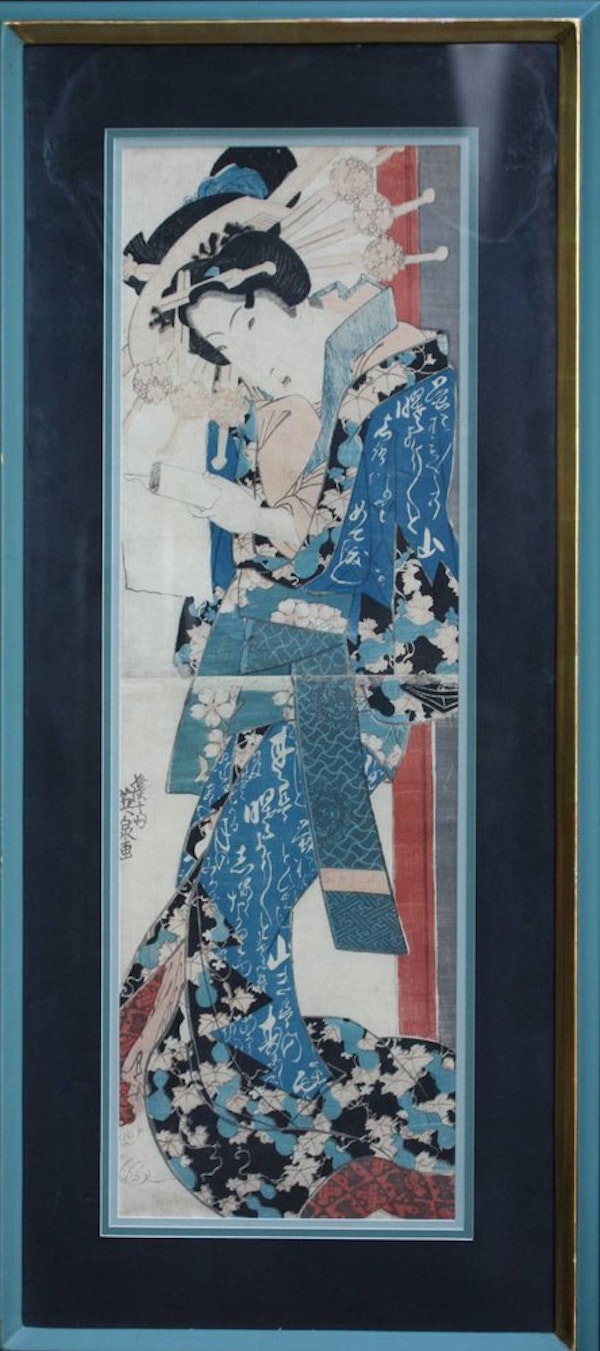Japanese 'bijin-ga' woodcut print, by Ikeda Eisen, also known as Keisai Eisen (1790-1848)
Japanese 'bijin-ga' woodcut print, by Ikeda Eisen, also known as Keisai Eisen (1790-1848)
POA
Description
Japanese 'bijin-ga' woodcut print, by Ikeda Eisen, also known as Keisai Eisen (1790-1848), of ‘kakemono-e’ format (vertical diptych) depicting an oiran (courtesan) standing beside a doorway reading a letter, her body curving in an s-shape, wearing layered kimono with blue silk brocade uchikake (outer robe) with a design of handwritten script, over a kimono featuring an ‘uri’ pattern of hyoutan gourd with intertwining vines and scrolling leaves, her obi with a design of cherry blossom clusters and tied at the front, her garments swept back to reveal her bare feet and innermost red kimono underlayer; her hair worn in the datehyougo style in a double topknot with large blossom kanzashi (hair ornaments); the signature reading ‘Keisai Eisen Ga’ 渓斎英泉画.
Condition: Central crease
Notes: This vertical diptych known in Japanese as ‘kakemono-e’ is a large, long format double print intended for hanging in an alcove space (床の間tokonoma). Traditionally, hanging scrolls with calligraphy, landscapes or classical scenes from fiction would have adorned these alcoves, but during the seventeenth and eighteenth centuries print publishers began producing ‘bijin’ prints of courtesans and other members of the so-called ‘floating worlds’ of the Yoshiwara and Edo theatre to hang in these spaces. The elongated shape enabled artists to experiment with form and produce innovative new designs, but as these pieces were indeed displayed on walls for long periods of time, it is rare to find surviving kakemono prints in good condition. Along with other artists including Eizan, Kuniyoshi, and Kunisada, Eisen produced a number of bijin kakemono, and is known for the overt sensuality of his style in the portrayal of courtesans of the Yoshiwara district. Various aspects of the woman’s appearance in this example, including her lavish and richly decorative kimono, her front-tied obi, ornate hair pins in an elaborate, heavily waxed hairstyle, her stance and bare feet make her easily identifiable as an ‘oiran’ (high ranking courtesan) of the district. Oiran generally did not wear white ‘tabi’ socks; the intimate glimpse of a bare foot from under the hem of her kimono was considered highly erotic, as was the just-visible glimpse of the red innermost layer. Ukiyo-e depictions of these women were highly stylised and idealised images of the Yoshiwara, designed to titillate and, more practically, advertise the supposed glamour and intrigue of the pleasure district to potential and returning customers. The activities of the women themselves were of course part of this intrigue, and courtesans were often depicted playing the part of yearning lover reading a long awaited letter from their beloved, as in this example, or writing a longing reply. The extravagant appearance, pomp and refined talents of the oiran were contrived, too, solely to appeal to the tastes of paying customers. Of course, the reality of life for these women, who were generally sold to the brothels of the Yoshiwara by their families around the age of seven or eight, was a far cry from the fantasy offered by Eisen and other ukiyo-e artists of the Edo period. Even the small minority of girls who showed promise and so were selected to undergo intensive oiran training were bound to their brothel, and held in ever-increasing debt as the expenses required for their upkeep rose along with their status and the prices of their services.
| item details | |
|---|---|
| Material and Technique | Woodblock 'bijin-ga' print in vertical diptych format |
| Origin | Japanese |
| Period | 19th Century |
| Dimensions | Dimensions of frame: 84.2cm. x 38.2cm. (33 1/8in. x 38.2cm); picture within mount: 65.2cm. x 20.5cm. (25 5/8in. x 8in.) |
Product REF: R835


